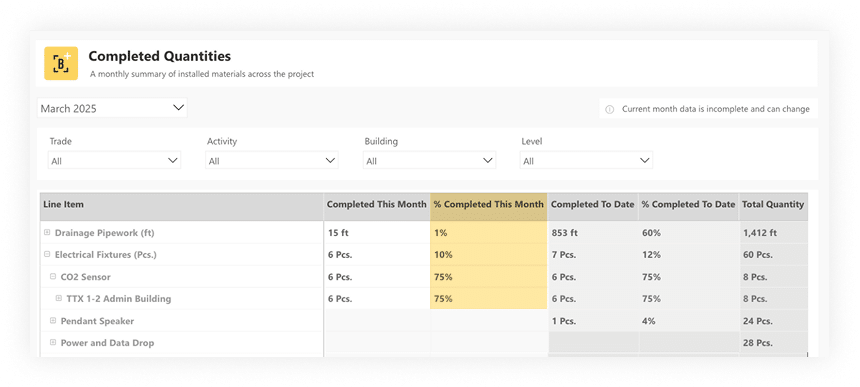Stop the guesswork: The struggle to maintain financial control in construction

Validate what’s billed vs. what’s built with Completed Quantities
TL;DR Most of today’s construction cost controls rely on subjective reporting and fragmented documentation. That’s why Buildots introduced Completed Quantities – a new feature that helps teams validate applications for payment using actual installed quantities, not assumptions or guesswork.
Managing project costs is a constant balancing act. GCs and owners often review and approve large payment applications under tight timelines with little visibility into actual progress. This doesn’t just risk overpayments. It breaks the alignment between payments and key project milestones, for example, if a trade claims 80% completion but has only delivered 50%. It also leaves room for inaccurate forecasting, which can disrupt healthy project cash flow.
The solution? It’s time to shift from “trust but verify” to “trust because it’s verified.”
The payment chain problem
There are two distinct operations in the construction payment process: the flow of funds from the owner to the GC and from the GC to the subcontractors.
In the first, the GC compiles a payment application detailing completed work and associated costs. The owner (often with input from consultants) reviews this application and, when satisfied, releases payment to the GC.
In the second, the GC receives payment from the owner and must distribute those funds to the subcontractors. Subcontractors submit their payment claims to the GC, indicating the completed work. Once satisfied, the GC validates and approves the claims and releases payments to the subcontractors.
In each scenario, one party is responsible for validating the previous link’s work and submitting their own application for payment. That means the entire chain is only as strong as the data it’s built on. But, too often, this process relies on:
- Verbal updates from field teams
- Manual site walks and rough estimates
- Assumptions about partial completions or projected progress
This introduces risk at every level. Overstated claims create cash flow distortions, and underreported work delays payment approvals. When the numbers aren’t tied to real progress, the result is disputes, financial misalignment, and time lost chasing clarity.
Introducing Completed Quantities
We want to usher in a new, more transparent era in construction payments. That’s why we created Buildots’ new Completed Quantities feature. It gives users a precise record of what has been installed each billing cycle and the total quantities installed. Information is presented in a single, easy-to-digest report.

Completed Quantities helps bring clarity and control to construction payments by providing an objective, data-driven way to track installed work. Owners, GCs and consultants can use this data in a few valuable ways.
- Validate what’s billed vs what’s built: Analyze payment applications to ensure they align with actual site progress, avoiding subjective opinions and fruitless discussions.
- Improve cash flow accuracy: Keep project finances on track by verifying installed quantities before approving payments.
- Enable trust across the project: GCs can confidently engage with subcontractors, addressing discrepancies early and ensuring fair payments. Similarly, owners gain full transparency when reviewing GC valuations – strengthening the ‘Act’ phase of Buildots’ Performance-Driven Construction Management methodology.
- Reduce time spent on data collection: Automate the tracking of installed materials and completed work, eliminating the need for manual data gathering and freeing teams to focus on higher-value tasks.
- Streamline payment processes: Simplify payment application validation and monthly valuations with objective, timestamped data.
Completed Quantities: Expanding PDCM principles into the financial sphere
Completed Quantities reinforces both the ‘Analyze’ and ‘Act’ phases of Buildots’ Performance-Driven Construction Management (PDCM) methodology – our first feature to apply PDCM principles to applications for payment.
It provides objective tracking of installed work, ensuring that financial reporting accurately reflects on-site progress, avoiding subjective opinions and fruitless discussions. And crucially, by establishing a shared source of truth for quantities installed, the feature strengthens communication, ensures alignment, and streamlines financial workflows across all project stakeholders.
A cultural change
Let’s be real. Completed Quantities represents a shift in how the construction industry approaches payment applications. And like all changes, it will require some getting used to. Contractors and subcontractors might worry about how it impacts their cash flow. That’s why it’s important to see Completed Quantities as a trust enabler – not a payment blocker. Aligning payments with verified progress creates a more predictable and accountable cash flow process.

In the long run, this proactive approach helps the entire construction ecosystem move towards healthier financial practices. By working from accurate data, payment cycles can become smoother, approval times shorter, and the risk of disputes much lower. Want to see it in action? Let’s talk.


